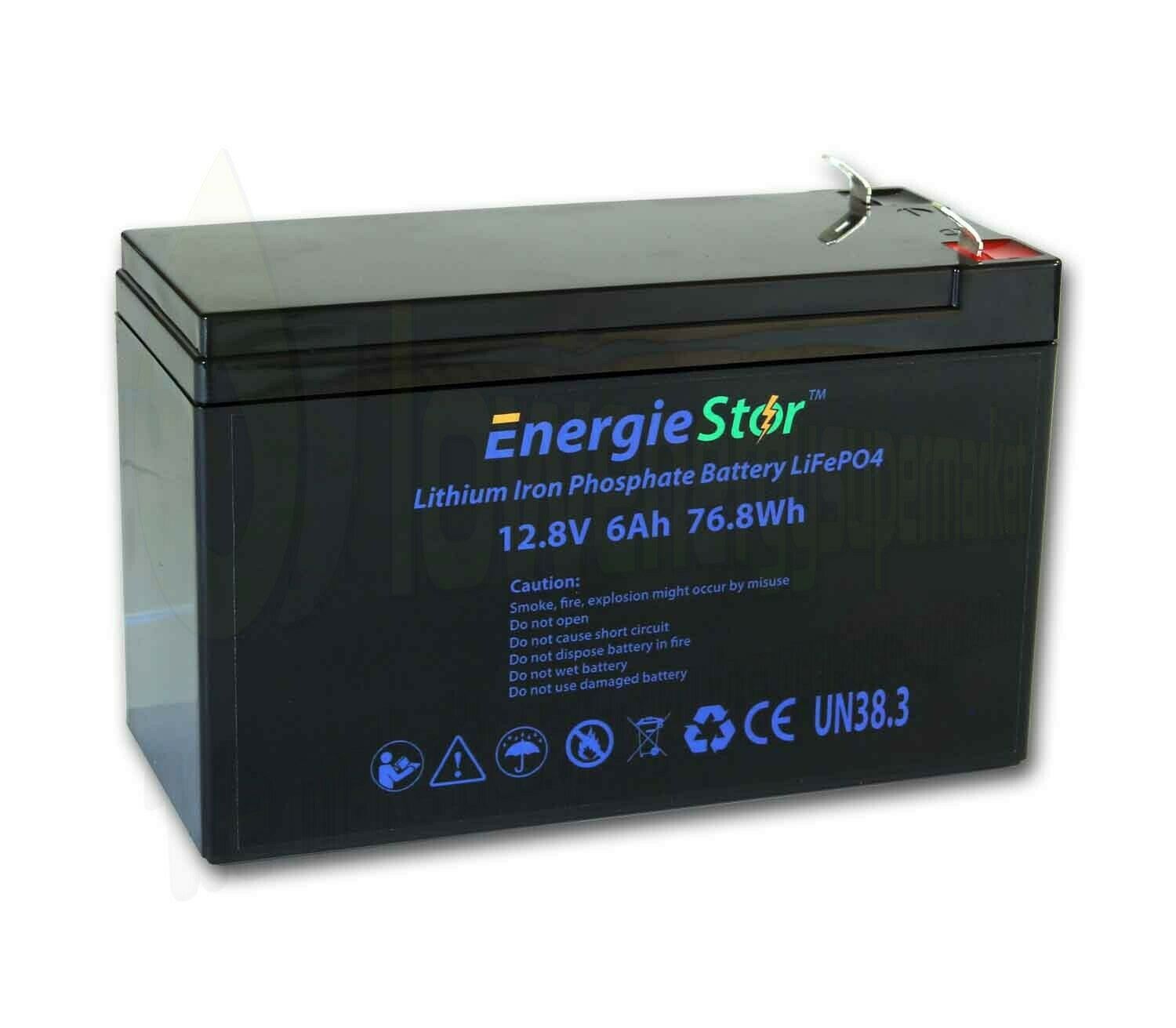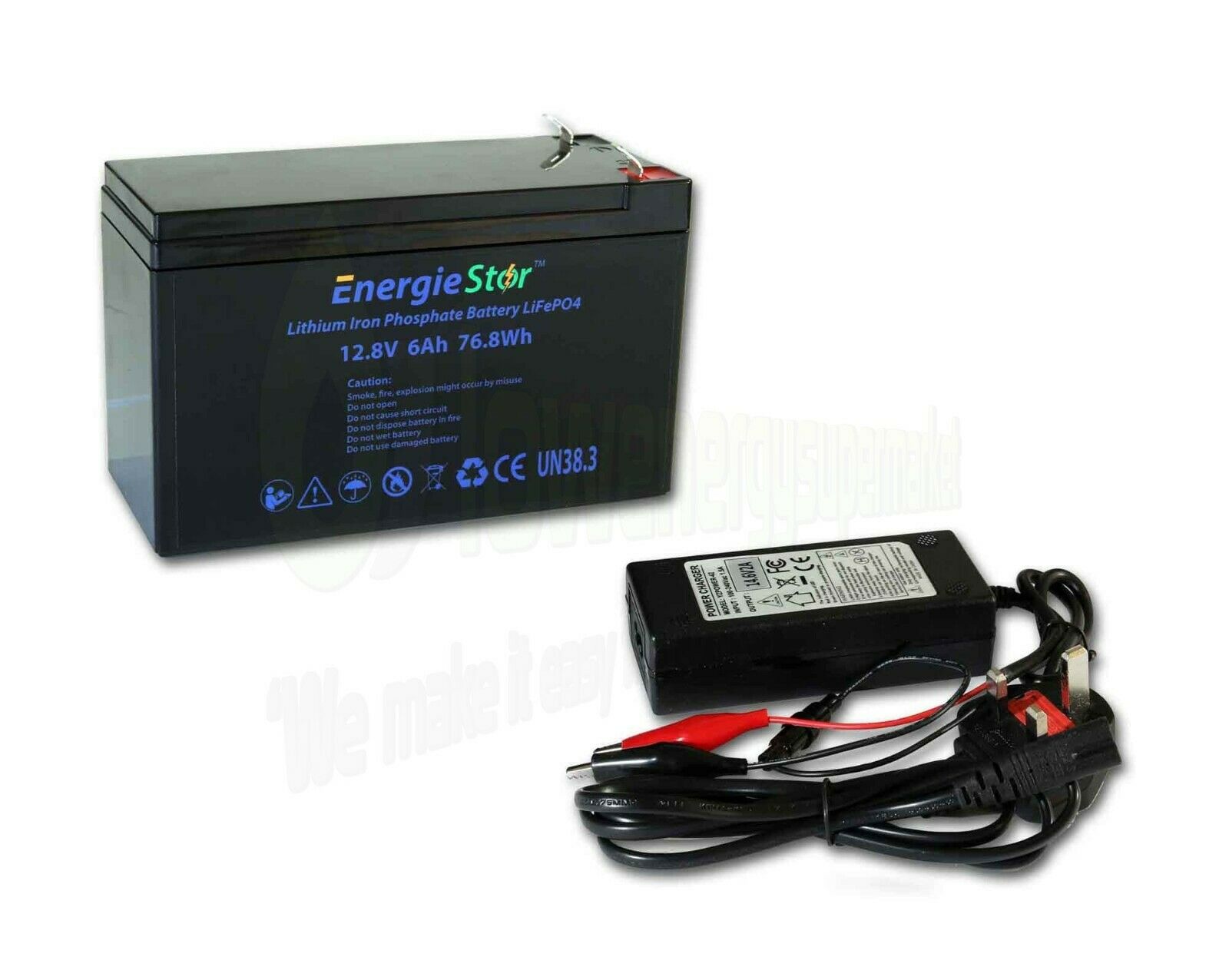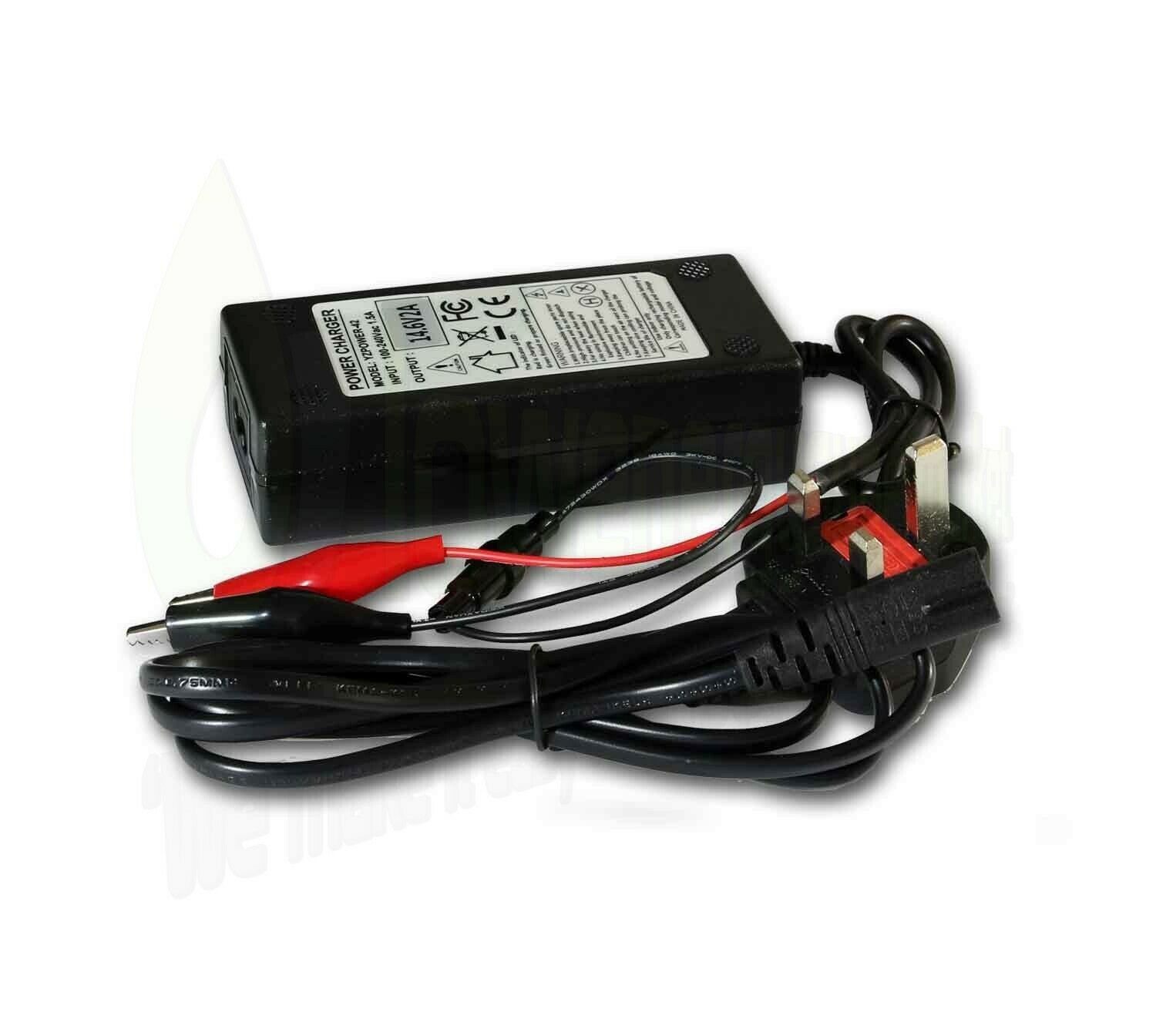Battery Specification All of our lithium batteries include low temperature cut-out protection which helps to preserve the cycle life of the battery. There is a Charging cut-out at 0 deg C and a discharging cut-out at -15 Deg C. Model Number 128-006 Rated Capacity (Ah) 6Ah Watt Hours Capacity (Wh) 76.8 Preferred Minimum Charge Current, 0.1C (Amps) There is NO minimum charge current, it must just be below 0.5C. These batteries are fully compatible with solar charging systems. Recommended Charge Current (Amps) 2A Max Charge Current (Amps) 3A Standard Continuous Discharging Current, 0.5C (Amps) 3A Max. Continuous Discharging Current, 1C (Amps) 6A Max. Peak Discharging Current for only 3-5 Seconds, 2C (Amps) 12A Weight Approx. 0.8kg Dimensions WxHxL (mm) 67x93x150 Height with Terminals (mm) 105 For All Battery Models Nominal Voltage 12.8V Max Charge Voltage 14.6V Discharge Cut Off Voltage 10.0V Outer Package Solid ABS Case PCB Protection Over-Charge, Over-Discharge, Overcurrent and Short Circuit Operating Temperature Storage & Charging 0~45℃ Discharging -20~60℃ Cycles 2000 cycles @100% D.o.D, after this, 80% capacity remaining Design Lifespan 15 to 20 Years Warranty 2 Years EnergieStor LiFePO4 Lithium Battery chargers These are designed to provide the slightly higher charge voltage to Lithium LiFePO4 batteries that is usually given out by Lead Acid battery chargers. These LiFePO4 Lithium battery chargers should always be used with Lithium batteries to ensure long service life. 2A Model - for 6Ah EnergieStor™ Battery, Dimensions WxHxL (mm) 50x33x170 Advantages of Lithium Batteries Disadvantages of Old Technology Lead Acid Batteries Lead Acid batteries were not perfect and had their own safety issues, as below:- A lead-acid battery must be securely mounted to avoid acid spillage They discharge a mix of hydrogen and oxygen which is created during higher charging levels. This can activate gas alarms such as a carbon-monoxide detectors Lead Acid battery gas is explosive and if it is ignited, the casing of a battery can be blown apart and its acid released, leading to injury or flesh burns. Accordingly, when charging a battery or disconnecting leads after a charge, ensure there are no naked flames nearby. Even a lighted cigarette can ignite the gas. It is time to phase out lead acid batteries due to their weight, dangerous acid base and outdated efficiency for these reasons:- 1, Limited “Useable” Capacity, 30 to 50% DOD only 2, Limited Cycle Life, maybe just 200 to 500 cycles, replacement maybe every 2 years 3, Slow & Inefficient Charging, the final 20% of lead acid battery capacity can not be “fast” charged 4, Wasted Energy, as much as 15% of the energy put into them is wasted due to inherent charging inefficiency. So if you provide 100 amps of power, you’ve only storing 85 amp hours. This can be especially frustrating when charging via solar. Battery Terminology Depth of Discharge (DOD), 100% DOD will reduce cycle life. 30% means using only 30% of the battery between each charge/ discharge cycle will give a very long cycle life for many years. As power is discharged from the battery, the battery voltage slowly drops which can be used to determine depth of discharge, (see our battery performance graphs in images). Cycle Life, all batteries eventually degrade. Cheap lead acid can degrade in just a few 100% discharges with battery suplation and dead a battery that will not hold charge very quickly. Typical lead acid batteries are usually around 200 to 500 cycles if the are well maintained with no more than 30 to 50% discharge. These Lithium batteries can be 2000 to 5000 cycles depending on the depth of discharge. One cycle is typical discharge to 30, 50 or 80% then full recharge, then next discharge cycle. Amp Hours (Ah) The maximum number of amps in the battery discharged over a moderate discharge rate. Watt-Hours (Wh). The number of watt hours in a battery is simply the battery voltage, say 12.8V multiplied by the Battery Ah, i.e. 12.8 x 100Ah = 1280Wh. This means, at 100% discharge, 1 watt can be discharged from this battery for 1280 hours, or 100 watts can be discharged from this battery for 12.8 hours. Note, the higher the battery discharge rate less watt hours maybe available, this applies to all types of batteries. Lithium Battery UN38.3 Testing Procedure Test 1 - Altitude Simulation Batteries are stored at a pressure of 11.6 KPa (simulating 50,000ft aircraft altitude) for at least six hours at 20°C. After the test, there is no leakage, no venting, no disassembly, no rupture, no fire and battery voltage is stable – TEST PASS Test 2 - Thermal Batteries are stored for at least 12 hours at a temperature of 72°C followed by storage of 12 hours at a temperature of - 40C. The procedure is to be repeated 10 times. All test batteries are then stored for 24 hours at 20°C. After the test, there is no leakage, no venting, no disassembly, no rupture, no fire and battery voltage is stable – TEST PASS Test 3 – Vibration Batteries are firmly secured to the platform of a vibration machine. The vibration shall be a sinusoidal waveform with a logarithmic sweep between 7 and 200Hz and back to 7Hz, traversed every 15 minutes. This cycle shall be repeated 12 times for a total of three hours. One of the directions of vibration must be perpendicular to the terminal face. After the test, there is no leakage, no venting, no disassembly, no rupture, no fire and battery voltage is stable – TEST PASS Test 4 – Shock Batteries are secured to a testing machine by means of a rigid mount which will support all mounting surfaces of the battery. Each battery is subjected to a shock of peak acceleration depending on the mass of the battery. Each battery is subjected to 3 shocks in the positive direction followed by three shocks in the negative direction for a total of 18 shocks. After the test, there is no leakage, no venting, no disassembly, no rupture, no fire and battery voltage is stable – TEST PASS Test 5 - External Short Circuit Batteries to be tested are first heated to 57°C. The battery it is then subjected to one short circuit by joining the positive and negative terminals with metal wire of less than 0.1 Ohm for at least one hour. After heating, the short circuit and cooling down phases are conducted at ambient temperature. In order to pass this test, batteries must not have an external temperature exceeding 170°C, there is no leakage, no venting, no disassembly, no rupture and no fire. Test PASS Test 6 – Crush A component cell is to be crushed between two flat surfaces. The crushing is to be continued until the first of three options is reached below A, the applied force reaches 13KN (approx.1325Kg) B, the voltage of the cell drops at least 100 mV C, the cell is deformed by 50% or more of its original thickness. Each component cell is to be subjected to one crush only. The test sample object is monitored for a further six hours. Requirement – component cells will pass this test, so long as their external temperature does not exceed 170°C, there should be no disassembly or fire during the test and within six hours after the test. TEST PASS Test 7 – Overcharge A charge current is applied to the battery which is twice the manufacturers recommended maximum continuous charge current. The test duration is 24 hours. Requirement – batteries will meet this requirement if there is no leakage, no venting, no disassembly, no rupture and no fire within seven days after the test. TEST PASS Test 8 – Forced Discharge Each component cell is forced discharge at ambient temperature by connecting it in series with a 12V DC power supply at a current equal to the maximum discharge current specified by the manufacturer. Each cell is force discharged for a time interval (in hours) equal to its rated capacity divided by the initial test current. Requirement – component cells meet this requirement if there is no disassembly and no fire during the test and within seven days after the test. TEST PASSIf using more than one of these batteries you MUST use a battery balancer
Do not connect smart (with Bluetooth) and non-smart lithium battery packs in series or parallel as this will invalidate the warranty. They must all be of the same type
Shipping
We post week days Monday - Friday via the postage option you chose at check out.
Please Note
We try to dispatch the same day however sometimes this is not possible due to our collection times. Some items due to their size or weight may be unavailable to customers in the Highlands or Islands.
Returns
In line with CCR any item can be returned to us within 30 days. We must be notified in writing of the cancellation and refunds can take upto 15 days.
The item must be in a re-sale condition, we will not cover any returns postage.
To comply with all UK building regulations any electrical work should be carried out by a UK certified electrician.
All electricity should be switched off prior to ANY electrical work being carried out.
Low Energy Supermarket accepts no responsibility for any electrical item purchased being installed and any item is fitted at owners risk. Please do not book any qualified tradespersons until goods are in hand.
All our items require immediate payment.
If you are wishing to purchase more than one item, click 'Add to Basket' and then proceed to the next item.
Once you have added all items to the basket, click the 'basket' icon in the top right corner of the page and complete payment.
Low Energy Supermarket is a certified carbon neutral plus company and was founded in 2010. We are a family run business based in Cheshire, UK. We offer various energy saving products which will help to reduce the ever rising energy bills.
We only offer quality products and bring these to you at the most competitive prices we can.
We are always expanding our range so please save us as a favorite seller or sign up to our newsletters to ensure you are one of the first to hear about our new items.
WEEE producer number: WEE/KC4239XX

 Search
Search Customer
Customer View
View








 LiFePo4 6Ah Rechargeable Battery 12.8V Lithium Iron Phosphate 12V with Charger
LiFePo4 6Ah Rechargeable Battery 12.8V Lithium Iron Phosphate 12V with Charger



